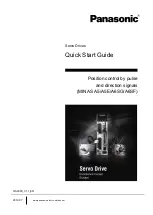
Terminal
Parameter
Default
setting
Description
Serial communication
61
–
–
Integrated RC
filter for cable
shield. ONLY for
connecting the
shield when
experiencing
EMC problems.
68 (+)
Parameter group
8-3* FC port
settings
–
RS485 interface.
A control card
switch is
provided for
termination
resistance.
69 (-)
Parameter group
8-3* FC port
settings
–
Relays
01, 02, 03
Parameter 5-40 Fun
ction Relay
[1] Control
Ready
Form C relay
output. These
relays are in
various locations
depending on
the frequency
converter config-
uration and size.
Usable for AC or
DC voltage and
resistive or
inductive loads.
Table 2.3 Terminal Descriptions - Serial Communication
2.2.4 Wiring to Control Terminals
Control terminal connectors can be unplugged from the
frequency converter for ease of installation, as shown in
For details about STO wiring, refer to
NOTICE
Keep control cables as short as possible and separate
them from high-power cables to minimize interference.
1.
Loosen the screws for the terminals.
2.
Insert sleeved control cables into the slots.
3.
Fasten the screws for the terminals.
4.
Ensure that the contact is firmly established and
not loose. Loose control wiring can be the source
of equipment faults or less than optimal
operation.
See
chapter 7.5 Cable Specifications
for control terminal
cable sizes and
chapter 3 Application Examples
for typical
control cable connections.
2.3 Control Structures
A frequency converter rectifies AC voltage from mains into
DC voltage. Then the DC voltage is converted into an AC
current with a variable amplitude and frequency.
The motor is supplied with variable voltage/current and
frequency, enabling infinitely variable speed control of 3-
phased standard AC motors and permanent magnet
synchronous motors.
2.3.1 Control Modes
The frequency converter controls either the speed or the
torque on the motor shaft. The frequency converter also
controls the process for some applications which use
process data as reference or feedback, for example,
temperature and pressure. Setting
parameter 1-00 Configu-
ration Mode
determines the type of control.
Speed control
There are 2 types of speed control:
•
Speed open-loop control, which does not require
any feedback from the motor (sensorless).
•
Speed closed-loop PID control, which requires a
speed feedback to an input. A properly optimized
speed closed-loop control has higher accuracy
than a speed open-loop control.
Select which input to use as speed PID feedback in
parameter 7-00 Speed PID Feedback Source
.
Torque control
The torque control function is used in applications where
the torque on motor output shaft controls the application
as tension control. Select
[2] Torque closed loop
or
[4]
Torque open loop
in
parameter 1-00 Configuration Mode
.
Torque setting is done by setting an analog, digital, or bus-
controlled reference. When running torque control, it is
recommended to run a full AMA procedure, because
correct motor data is important in achieving optimal
performance.
•
Closed-loop in VVC
+
mode. This function is used
in applications with low to medium dynamic
variation of shaft and offers excellent
performance in all 4 quadrants and at all motor
speeds. The speed feedback signal is mandatory.
Ensure that the encoder resolution is at least
1024 PPR, and the shield cable of the encoder is
properly grounded, because the accuracy of the
speed feedback signal is important. Tune
parameter 7-06 Speed PID Lowpass Filter Time
to
get the best speed feedback signal.
•
Open-loop in VVC
+
mode. The function is used in
mechanically robust applications, but the
accuracy is limited. Open-loop torque function
Product Overview
Design Guide
MG07B102
Danfoss A/S © 03/2016 All rights reserved.
17
2
2
















































